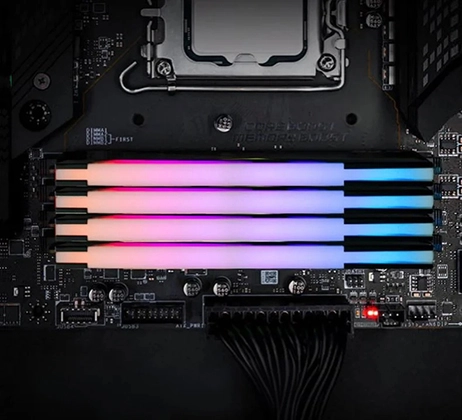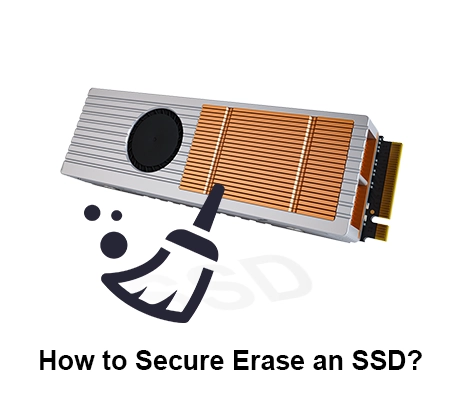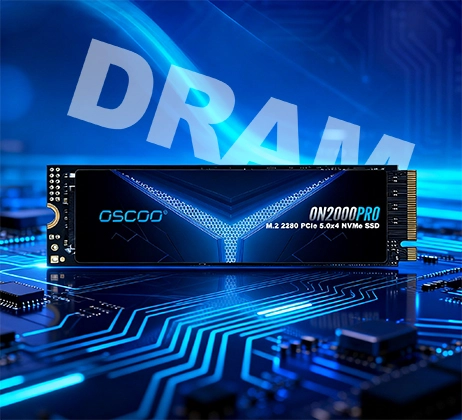
By Form Factors
2.5-inch SATA SSD
M.2 SSD
M.2 SSDs look completely different. They resemble a small, narrow circuit board, often described as “gum-stick” sized. These drives don’t need separate data or power cables. Instead, they plug directly into a dedicated M.2 slot on the motherboard, similar to installing RAM, and are secured there. Despite its small size, the M.2 form factor hides significant potential. Its speed can vary greatly, depending on whether it uses the older SATA protocol or the more efficient NVMe protocol internally. It’s important to note that some M.2 SSDs have the new shape but still use the SATA protocol internally. Their speed is then no different from traditional 2.5-inch SATA drives. The truly fast ones are those using the NVMe protocol. They can utilize much faster pathways, achieving speeds far exceeding SATA.
M.2 drives also come in different lengths, commonly labeled 2230, 2242, 2260, 2280, and 22110. These numbers represent the drive’s dimensions in millimeters. For example, 2280 means 22mm wide and 80mm long. The 2280 size is currently the most mainstream.
M.2 NVMe SSDs have distinct advantages: their compact size is ideal for thin laptops; installation is convenient; and they offer extremely fast speeds, making them the absolute mainstream choice for high-performance desktops and laptops. Of course, higher speed usually means a higher price. Also, older computer motherboards might lack an M.2 slot or might not support the NVMe protocol.
mSATA SSD
U.2 SSD
U.2 SSDs, also known as SFF-8639 SSDs, look somewhat similar to 2.5-inch drives at first glance but are usually thicker and have a completely different interface. They use a specially designed U.2 interface, typically requiring an additional cable. The key feature of these drives is that they internally use the high-performance NVMe protocol over the fast PCIe channel. This makes them very fast, rivaling or even exceeding top-tier M.2 NVMe SSDs under certain conditions. Additionally, U.2 drives are designed for better heat dissipation and support “hot-swapping” in compatible server or workstation cases. Hot-swapping allows drive replacement while the computer is running.
Because of these features, U.2 SSDs primarily target enterprise users, data centers, and professional workstations requiring extremely high performance, stability, and reliability. They are relatively expensive. Standard home desktop and laptop motherboards usually lack a U.2 interface, and your computer case also needs specific support. Therefore, the vast majority of ordinary consumers will almost never encounter this form factor.
By Interface
SATA
PCIe via NVMe
When you need higher speed, the PCIe (Peripheral Component Interconnect Express) channel combined with the NVMe protocol is the current mainstream and most powerful solution. Note two key points: the physical channel is PCIe, and the communication protocol is NVMe. NVMe, which stands for NVM Express, is a modern protocol designed specifically for high-performance flash storage. It is far more efficient than the older AHCI protocol used for SATA.
This combination primarily connects to the motherboard via the M.2 interface or the U.2 interface. Very few SSDs are made as PCIe expansion cards plugged directly into a motherboard’s PCIe slot. Performance is impressive because the PCIe channel acts like a multi-lane highway. Actual speeds depend on the PCIe version supported by the motherboard and the number of lanes allocated to the SSD. For example, the common PCIe 3.0 x4 configuration has a theoretical maximum speed of about 3500 MB/s. The newer PCIe 4.0 x4 doubles this to around 7000 MB/s. The latest PCIe 5.0 x4 offers another significant leap. Therefore, M.2 NVMe and U.2 interface SSDs represent the fastest mainstream consumer SSDs available today. Before buying, confirm your motherboard is compatible with NVMe and can provide the required PCIe version and lane configuration.
USB
These interfaces (especially USB 3.x / USB4 / Thunderbolt) are primarily used for external portable SSDs. An external SSD typically contains a standard internal SSD core, like an M.2 NVMe or SATA drive, housed within an enclosure featuring the external interface. Common physical ports are USB Type-A or the more advanced Type-C. Data transfer uses the USB Mass Storage protocol.
The core value of these interfaces is excellent portability and plug-and-play, also known as hot-swap, capability. This makes them ideal for mobile work, backups, or sharing data between different devices. However, their speed ceiling heavily depends on the USB version. Mainstream USB 3.2 Gen 1 offers up to about 500 MB/s. Faster options include USB 3.2 Gen 2 at about 1000 MB/s. Top-tier interfaces like USB 3.2 Gen 2×2, USB4, or Thunderbolt can provide speeds of 2000-4000+ MB/s or higher. It’s crucial to note that even if the internal drive is a high-performance NVMe SSD, the final file transfer speed cannot exceed the theoretical limit of the USB interface itself.
By Deployment
Internal SSD
An internal SSD is installed inside the computer device. It connects to dedicated interfaces provided by the motherboard, such as the SATA port, M.2 slot, or U.2 interface mentioned earlier. In this deployment, SSDs primarily serve two roles: System Drive or Internal Storage Drive: As a system drive, it holds the operating system and frequently used software, directly determining boot times and application responsiveness. As internal storage, it holds games, large files, media libraries, etc. When connected internally, especially via high-speed PCIe channels like M.2 NVMe, the SSD’s performance potential is fully realized.
Common forms include the 2.5-inch SATA drive, M.2 drive (whether SATA or NVMe protocol), and the enterprise-oriented U.2 drive. Its main advantages are performance reaching the limits of its specifications (constrained by the interface), no need for external carrying, and no separate power cables as the motherboard usually powers it directly. The disadvantage is its fixed location. Data is only accessible within that specific device, lacking portability.
External SSD
An external SSD is located outside the computer device and connected via a cable to a USB port, or sometimes a Thunderbolt port. They usually have a portable casing. The core purpose of these SSDs is portable, mobile storage. Their greatest value lies in portability and plug-and-play, or hot-swap, capability. You can easily move or share large amounts of data between different computers, such as office PCs, home PCs, and laptops, or even some devices supporting USB storage like game consoles or TVs. When traveling, a compact external SSD provides substantial mobile storage space.
An external SSD is essentially an internal SSD combined with an interface adapter enclosure, often called a drive enclosure or portable enclosure. The core storage unit inside the enclosure could be a 2.5-inch SATA SSD or a smaller M.2 SSD (SATA or NVMe protocol). However, regardless of how fast the internal NVMe SSD might be, the overall transfer speed of the external SSD is strictly limited by the speed rating of the USB or Thunderbolt interface. For example, an external drive containing a high-end internal NVMe SSD connected via a USB 3.0 port will max out at the USB 3.0 speed limit, about 500 MB/s, far below the internal performance of that NVMe drive.
The advantages of external SSDs are clear: compact and lightweight, extremely convenient to use, offering physical data isolation for some security, and meeting cross-device data sharing needs. Their limitations are speed constrained by the external interface and reliance on a connecting cable, sometimes requiring a separate power cable, although most draw sufficient power from USB.
In summary, the deployment choice depends on the core purpose: choose an internal SSD for maximum performance as the primary internal storage; choose an external SSD for data you need to physically carry and share easily between different devices. Remember, the speed bottleneck for external SSDs is their external interface, not the potential of the internal drive.
By Target Platform
- Consumer/Client: Aimed at the general public.
- Enterprise: Designed for demanding environments.
Consumer SSD
Consumer SSDs target the broad market of individual users. This includes home users, students, gamers, and creators doing photo/video editing in non-intensive professional scenarios. The core design principle is finding the best balance between performance, capacity, reliability, and price. Performance-wise, they are typically fast enough to significantly improve daily use, making the system responsive and drastically reducing game load times. Current mainstream choices use the NVMe protocol over PCIe channels or the SATA interface, with NVMe SSDs becoming the preferred choice for new builds or upgrades.
Capacity options are very wide, ranging from entry-level 250GB/500GB to mainstream 1TB/2TB, and even 4TB or larger capacities offered by some manufacturers to meet different storage needs. Most use TLC type NAND flash memory chips to balance performance and cost. Some models pursuing maximum capacity at low prices might use QLC. Their endurance, usually measured in “Total Bytes Written” or TBW, is sufficient for several years of typical use. Manufacturers generally provide a 3 to 5-year limited warranty as assurance. In short, the core of consumer SSDs is providing adequate performance, reliable quality, and tangible value, meeting the vast majority of daily and entertainment computing needs.
Enterprise SSD
Enterprise SSDs target users in data center servers, large storage arrays, high-performance computing clusters, and critical business workstations. The demands in these environments are extremely stringent. Design priorities are extreme reliability, unparalleled endurance, stable performance under continuous heavy loads, and top-tier performance, especially in handling massive amounts of small random read/write operations. The stability requirement is 24/7 operation without interruption or failure. To ensure data safety, they incorporate enhanced features like power-loss protection to prevent data loss during outages, end-to-end data protection to ensure integrity during transfers, and hot-swap support for replacing drives without shutting down the server.
In terms of internal components, enterprise SSDs generally use higher-grade NAND flash memory. Commonly, this is specially optimized enterprise-grade eTLC, which is more write-tolerant and longer-lasting than consumer TLC, or technologies that simulate SLC performance using smarter caching. The most significant difference is their write endurance TBW rating, often many times or even dozens of times higher than consumer drives of similar capacity. They primarily come in the U.2 form factor, though some high-end models use M.2 or larger EDSFF form factors to meet cooling and sustained workload demands. Enterprise SSDs are rarely sold retail and are much more expensive than consumer products. Support typically involves long-term, tailored service agreements. In essence, enterprise SSDs are professional tools built for high-intensity, critical, mission-critical business environments, sacrificing cost to achieve data-center-grade rock-solid dependability.





